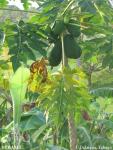1 CHARLES C, 1988 TRAMIL survey. Movement for Cultural Awareness MCA, Roseau, Dominica.
2 WENIGER B, ROUZIER M, 1986 Enquête TRAMIL. Service Oecuménique d'Entraide SOE, Port au Prince, Haïti.
3 MAC LEOD AJ, PIERIS NM, 1983 Volatile components of papaya (Carica papaya L.) with particular reference to glucosinolate products. J Agric Food Chem31(5):1005-1008.
4 JINDAL KK, SINGH RN, 1975 Phenolic content in male and female Carica papaya: Possible physiological marker for sex identification of vegetative seedlings. Physiol Plant 33:104-107.
5 TANG CS, 1971 Benzyl isothiocyanate of papaya fruit. Phytochemistry 10:117.
6 HASHEM FM, HAGGAG MY, GALAL AMS, 1980 A phytochemical study ofCarica papaya L. growing in Egypt. Egypt J Pharm Sci 21(3/4):199-214.
7 SILVARAJ Y, PAL DK, 1982 Changes in the chemical composition of papaya (Thailand variety) during growth and development. J Food Sci Technol 19:257-259.
8 PICKERSGILL R, SUMNER I, GOODENOUGH P, 1990 Preliminary crystallographic data for protease omega. Eur J Biochem190(2):443-444.
9 GIMLETTED JD, 1939 A dictionary of Malayan medicine. New York, USA: Oxford University Press.
10 ARGUETA A, CANO L, RODARTE ME, 1994 Atlas de las plantas de la medicina tradicional mexicana. Tomo II. México D.F., México: Instituto Nacional Indigenista. p1117-1119.
11 IDSTEINS H, BAUER C, SCHREIER P, 1985 Volatile acids in tropical fruits: cherimoya (Annona cherimolia Mills.), guava (Psidium guajava L.), mango (Mangifera indica L. var. alphonso), papaya (Carica papaya L.). Z Lebensm Unters Forsch 180(5):394-397.
12 KERHARO J, ADAM J, 1974 La Pharmacopée sénégalaise traditionnelle. Paris, France: Ed. Vigot Frères.
13 DUKE JA, 1992 Handbook of phytochemical constituents of GRAS herbs and other economic plants.Boca Raton, USA: CRC Press.
14 HEGNAUER R, 1973 Chemotaxonomie der Pflanzen. Basel, Schweiz: Birkhauser Verlag. 6:882.
15 TANG C, 1979 New macrocyclic piperideine alkaloids from papaya leaves: dehydrocarpaine I and II. Phytochemistry18(4):651-652.
18 DUKE JA, ATCHLEY AA, 1986 Handbook of proximate analysis tables of higher plants. Boca Raton, USA: CRC Press. p36.
19 CACERES A, 1992 Antigonorrhoeal activity of plants used in Guatemala for the treatment of sexually transmitted diseases. Informe TRAMIL. Facultad de Farmacia, Universidad de San Carlos, Guatemala, Guatemala.
20 CACERES A, MENENDEZ H, MENDEZ E, COHOBON E, SAMAYOA BE, JAUREGUI E, PERALTA E, CARRILLO G, 1995 Antigonorrhoeal activity of plants used in Guatemala for the treatment of sexually transmitted diseases. J Ethnopharmacol 48(2):85-88.
21 EMERUWA AC, 1982 Antibacterial substances from Carica papaya fruit extract. J Nat Prod 45(2):123-127.
22 OSATO JA, SANTIAGO LA, REMO GM, CUADRA MS, MORI A, 1993 Antimicrobial and antioxidant activities of unripe papaya. Life Sci 53(17):1383-1389.
23 GEORGE M, PANDALAI KM, 1949 Investigations on plant antibiotics. Part IV. Further search for antibiotic substances in Indian medicinal plants. Indian J Med Res 37:169-181.
24 GUNDIDZA M, 1986 Screening of extracts from Zimbabwean higher plants II: antifungal properties. Fitoterapia 57(2):111-113.
25 GIORDANI R, SIEPAIO M, MOULIN-TRAFFORT J, REGLI P, 1991 Antifungal action of Carica papaya latex: isolation of fungal cell wall hydrolysing enzymes. Mycoses (Marseille)34(11/12):469-477.
26 KAMBU K, TONA L, KABA S, CIMANGA K, MUKALA N, 1990 Antispasmodic activity of extracts proceeding of plant antidiarrheic traditional preparations used in Kinshasa, Zaire. Ann Pharm Fr48(4):200-208.
27 YASUKAWA K, YAMAGUCHI A, ARITA J, SAKURAI S, IKEDA A, TAKIDO M, 1993 Inhibitory effect of edible plant extracts on 12-O-tetradecanoylphorbol-13-acetate-induced ear oedema in mice. Phytother Res 7(2):185-189.
28 CHEN CF, CHEN SM, CHOW SY, HAN PW, 1981 Protective effects of Carica papaya Linn on the exogenous gastric ulcer in rats. Am J Chin Med 9(3):205-212.
29 GUPTA A, WAMBEBE CO, PARSONS DC, 1990 Central and cardiovascular effects of the alcoholic extract of the leaves of Carica papaya.Int J Crude Drug Res28(4):257-266.
30 STARLEY IF, MOHAMMED P, SCHNEIDER G, BICKLER SW, 1999 The treatment of pediatric burns using topical papaya. Burns 25 (7):636-639.
31GRANDVAUX J, 1986 Carica papaya, plante médicinale d'actualité. Thèse pharmacie nº 6/86, Paris XI, France.
32 PHILLIPSON J, O'NEILL M, 1987 Antimalarial & amoebicidal natural products. In: HOSTETTMANN K, LEA PJ, (Eds). Biologically active natural products. Oxford, USA: Oxford Science Publications. p49-64.
33 POUSSET JL, 1989 Plantes médicinales africaines. Paris, France: ACCT Ed.
34 MONERET VAUTRIN DA, BENOIST M, LAXENAIRE MC, CROIZIER A, GUEANT JL, 1985 Allergy to chymopapain: value of predictive tests before chemonucleolysis. Ann Fr Anesth Reanim4(3):313-315.
35 SOUZA BRITO A, 1988 Acute toxicity of the aqueous extract of Carica papaya.(Toxicidad aguda del extracto acuoso de raíz de Carica papaya). Informe TRAMIL. Dep. de Fisiología y Biofísica, Universidad de Campinas, Campinas, Brasil.
36 GarcIa-GonzAlez M, Coto MT, GonzAlez CS, Pazos L, 2001 Repeated dose dermal irritability of the grated fresh fruit of Carica papaya. (Irritabilidad dérmica del fruto fresco rallado de Carica papaya dosis repetida). Informe TRAMIL. Laboratorio de Ensayos Biológicos LEBI, Escuela de Medicina, Universidad de Costa Rica, San Pedro, Costa Rica.
37 ENO AE, OWO OI, ITAM EH, KONYA RS, 2000 Blood pressure depression by the fruit juice of Carica papaya (L.) in renal and DOCA-induced hypertension in the rat. Phytother Res 14(4):235-239.
38 CHINOY NJ, GEORGE SM, 1983 Induction of functional sterility in male rats by low dose of Carica papaya seed extracts treatment. Acta Eur Fertil14(6):425-432.
39 EINARSON TR, BOOTMAN JL, SMITH GH, 1980 Chymopapain. Drug Intell Clin Pharm18:560-568.
40 BADIN R, CASSAIGNE R, CHRISTIE RB, 1978 Papain in pharmaceutical enzymes.Gand, Belgium: Ed.D.Rüyssen & A.Lauwers.
































